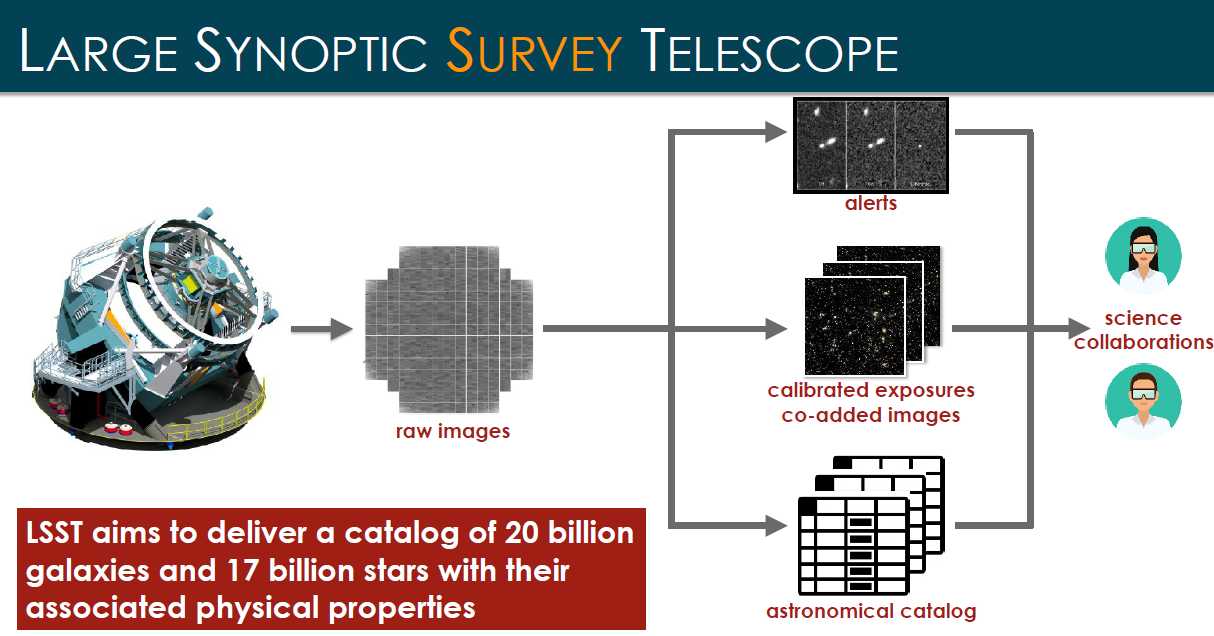LSST Camera: Key Details
| Feature | Description |
|---|---|
| Purpose | Capture vast swaths of the night sky with exceptional detail and speed |
| Scientific Goals | Map dark matter, explore dark energy, discover new objects, understand transient phenomena |
| Project Cost | Over $800 million |
| Primary Funder | National Science Foundation (NSF) with international contributions |
| Pixel Count | 3.2 billion (189 x 16 megapixel CCD sensors) |
| Special Features | Cryogenic system for -100°C operation, wide field of view, filter system |
| Survey Duration | 10 years |
| Expected Data | 15 petabytes |
| Data Access | Publicly available |
| Benefits | Advance understanding of the universe, foster scientific collaboration |
The Large Synoptic Survey Telescope (LSST) camera isn’t your average point-and-shoot. Forget capturing fleeting moments; this behemoth is meticulously designed to capture the grand narrative of the cosmos, one celestial brushstroke at a time. With its unprecedented scale, technological prowess, and ambitious scientific goals, the LSST camera stands as a testament to human ingenuity and a harbinger of groundbreaking discoveries. This analysis delves into the intricate details of this astronomical marvel, exploring its history, price tag, inner workings, construction process, and groundbreaking scientific mission.
A Legacy Forged in the Fires of Innovation: A Historical Perspective
The LSST camera’s story starts not with its construction, but with a burgeoning dream. In the late 1980s, astronomers envisioned a powerful survey telescope capable of capturing vast swaths of the night sky with exceptional detail and speed. This ambitious project, aptly named the Dark Matter Telescope, aimed to unravel the mysteries of dark matter, a perplexing substance believed to constitute a significant portion of the universe’s mass.
Over the next two decades, the project underwent numerous iterations, eventually evolving into the LSST we know today. Key technical breakthroughs like the development of high-performance, large-format CCD sensors paved the way for the camera’s immense pixel count. International collaborations formed, bringing together expertise from across the globe to tackle this monumental undertaking.
A Price Tag Befitting its Ambition: The Financial Landscape
The sheer scale and sophistication of the LSST camera translate into a hefty price tag. With an estimated total project cost exceeding $800 million, the LSST represents a significant investment in astronomical research. Funding comes from a consortium of public and private institutions, with the National Science Foundation (NSF) being the primary US contributor. International partners like Chile, Brazil, and Australia also play a crucial role in funding and collaborating on the scientific endeavor.
The high cost can be attributed to several factors, including:
- Cutting-edge technology: The camera utilizes state-of-the-art CCD sensors, high-performance optics, and a complex cryogenic system, all pushing the boundaries of technological capabilities.
- Massive scale: The sheer size of the camera and its intricate components necessitates significant resources and advanced manufacturing techniques.
- Long-term operation: The LSST embarks on a ten-year survey mission, requiring robust infrastructure, data storage solutions, and ongoing maintenance.
While the price tag might seem astronomical (pun intended), the potential scientific returns and the advancement of human knowledge promise to be immensely valuable.
The Heart of the Machine: Unveiling the LSST Camera’s Mechanism
At the heart of the LSST lies its colossal camera system. Let’s delve into the intricate components that orchestrate the capture of celestial wonders:
- Focal Plane Array: The crown jewel of the camera is its focal plane array, a mosaic of 189 CCD (Charge-Coupled Device) sensors. Each sensor boasts 16 megapixels, bringing the total pixel count to a staggering 3.2 billion. This immense resolution allows for capturing faint objects and subtle details often invisible to other telescopes.
- Cryogenic System: To achieve optimal performance, the CCD sensors operate at a frigid -100°C. A sophisticated cryogenic system ensures this extreme temperature is maintained, minimizing noise and capturing pristine images of the cosmos.
- Optical System: Light from celestial objects is collected by a large, three-mirror design that focuses it onto the focal plane array. This complex optical system delivers sharp, high-quality images across the camera’s wide field of view.
- Shutter and Filter System: A mechanical shutter controls the exposure time, allowing for precise control over the amount of light captured. Additionally, a carousel of filters permits observations at specific wavelengths, revealing different features of celestial objects.
- Data Acquisition System: Captured data from the CCD sensors is processed and digitized by a sophisticated electronics system. This system ensures the integrity of the data before it’s transferred for storage and analysis.
From Raw Materials to Cosmic Cartographer: The Manufacturing Process
The construction of the LSST camera is an engineering marvel in itself. Here’s a glimpse into the meticulous process that brought this astronomical instrument to life:
- Sensor Fabrication: The high-performance CCD sensors are meticulously manufactured in specialized cleanroom facilities. Each sensor undergoes rigorous testing to ensure the highest quality and performance.
- Optics Polishing: The three mirrors of the optical system require meticulous polishing to achieve the necessary level of precision. This process involves sophisticated polishing machines and rigorous quality control procedures.
- Camera Assembly: The various components – the focal plane array, cryogenic system, optical system, and others – are meticulously assembled in a controlled environment. This intricate process ensures perfect alignment and optimal performance.
- Integration and Testing: Following assembly, the camera undergoes a rigorous series of tests to verify its functionality and performance. Engineers simulate various operating conditions, analyze image quality, and ensure all systems operate seamlessly.
- A Decade-Long Journey: The LSST Camera’s Scientific Mission
- The LSST camera embarks on a ten-year odyssey, meticulously surveying the southern hemisphere night sky. This ambitious program aims to capture a vast amount of data, estimated to be around 15 petabytes (equivalent to 15 million gigabytes). Here’s a glimpse into the scientific goals driving this monumental undertaking:
- Mapping Dark Matter: By studying the subtle gravitational influence of unseen dark matter on the movement of galaxies, the LSST camera hopes to create a detailed map of dark matter distribution across the universe.
- Exploring Dark Energy: Through observations of distant supernovae, the LSST aims to shed light on the mysterious force of dark energy, which is believed to be accelerating the universe’s expansion.
- Discovering New Objects: The vastness of space holds countless mysteries. The LSST camera’s ability to survey large areas with exceptional detail is likely to unveil previously unknown asteroids, comets, and other celestial bodies.
- Understanding Transient Phenomena: From exploding stars to colliding galaxies, the LSST will capture fleeting celestial events, providing valuable insights into the dynamic nature of the universe.
- The data collected by the LSST camera will be publicly available, fostering collaboration among scientists worldwide. This open-access approach democratizes astronomical research, allowing scientists from diverse backgrounds to contribute to our understanding of the cosmos.
- The Legacy of the LSST Camera: Beyond Pixels and Starlight
- The LSST camera is more than just a sophisticated instrument; it represents a leap forward in human exploration. It’s a testament to international collaboration, pushing the boundaries of technology and scientific inquiry. The insights gleaned from this ten-year mission promise to revolutionize our understanding of the universe, fostering new discoveries and shaping the future of astronomy.
- As the LSST camera embarks on its grand survey, it weaves a new chapter in the human story – a story of unyielding curiosity and the relentless pursuit of knowledge. With each captured image, this astronomical marvel unveils a piece of the cosmic tapestry, forever changing our perspective on the vast and wondrous universe we inhabit.



